
Frederick Donald Coggan, Baron Coggan, was the 101st Archbishop of Canterbury from 1974 to 1980. As Archbishop of Canterbury, he "revived morale within the Church of England, opened a dialogue with Rome and supported women's ordination". He had previously been successively the Bishop of Bradford and the Archbishop of York.

Sir Arthur William Blomfield was an English architect. He became president of the Architectural Association in 1861; a Fellow of the Royal Institute of British Architects in 1867 and vice-president of the RIBA in 1886. He was educated at Trinity College, Cambridge, where he studied Architecture.

St George the Martyr is a church in the historic Borough district of south London. It lies within the modern-day London Borough of Southwark, on Borough High Street at the junction with Long Lane, Marshalsea Road, and Tabard Street. St George the Martyr is named after Saint George. The church is a Grade II* listed building.

Stuart Yarworth Blanch, Baron Blanch, was an Anglican clergyman. Little interested in religion in his youth, he became a committed Christian at the age of 21, while serving in the Royal Air Force during the Second World War.

William Romaine, evangelical divine of the Church of England, was author of works once highly thought of by the evangelicals, the trilogy The Life, the Walk, and the Triumph of Faith.

The Church of St Martin is an ancient Church of England parish church in Canterbury, England, situated slightly beyond the city centre. It is recognised as the oldest church building in Britain still in use as a church, and the oldest existing parish church in the English-speaking world, although Roman and Celtic churches had existed for centuries. The church is, along with Canterbury Cathedral and St Augustine's Abbey, part of a World Heritage Site.
Mark David Oakley is a British Church of England priest. He is Dean of Southwark and formerly Dean of St John's College, Cambridge.
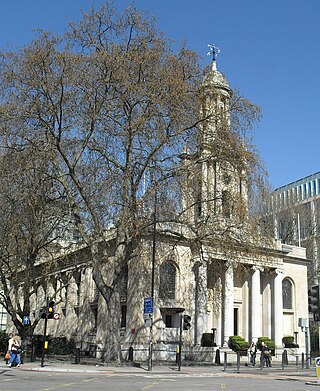
Holy Trinity Church, in Marylebone, Westminster, London, is a Grade I listed former Anglican church, built in 1828 and designed by John Soane. In 1818 Parliament passed an act setting aside one million pounds to celebrate the defeat of Napoleon. This is one of the so-called "Waterloo churches" that were built with the money. The building has an entrance off-set with four large Ionic columns. There is a lantern steeple, similar to St Pancras New Church, which is also on Euston Road to the east.
David Lawrence Edwards was an Anglican priest, scholar and church historian. He served as the Dean of Norwich, Chaplain to the Speaker of the House of Commons, Sub-Dean at Westminster Abbey and Provost of Southwark, and was a prolific author.

Cotham Church is a Gothic Revival style church in Cotham, Bristol, England. Since 1975, it has been a Church of England parish church known as the Church of St Saviour with St Mary or simply as Cotham Parish Church.

Peter Wheatley is a retired bishop in the Church of England. From 1995 to 1999, he was the Archdeacon of Hampstead. From 1999 to 2014, he was the Bishop of Edmonton, an area bishop in the Diocese of London.

Christopher Thomas James Chessun is a British Anglican bishop. Since 2011, he has been Bishop of Southwark in the Church of England.
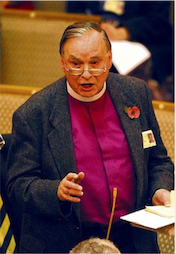
Colin Ogilvie Buchanan was a British Anglican bishop and academic who specialised in liturgy. He served as the principal of St John's College, Nottingham (1979–1985), Bishop of Aston (1985–1989) and Bishop of Woolwich (1996–2004).
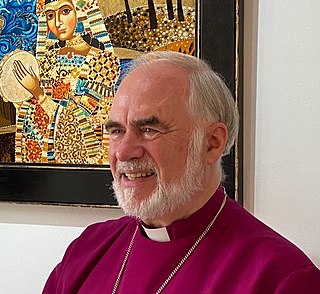
Graham Kings is an English Church of England bishop, theologian and poet. In retirement in Cambridge, having served as Bishop of Sherborne and then Mission Theologian in the Anglican Communion, he is an Honorary Assistant Bishop in the Diocese of Ely and Research Associate at the Cambridge Centre for Christianity Worldwide, which he founded in 1996. His latest books are: Nourishing Connections , Nourishing Mission: Theological Settings , Exchange of Gifts: The Vision of Simon Barrington-Ward , edited with Ian Randall.

The Church of St Thomas of Canterbury and English Martyrs is the Roman Catholic church serving St Leonards-on-Sea, a town and seaside resort which is part of the Borough of Hastings in East Sussex, England. The present church, which combines a plain, unadorned Gothic Revival exterior with a lavishly decorated interior featuring extensive early 20th-century paintings by Nathaniel Westlake, is the third building used for Roman Catholic worship in the seaside resort. James Burton's new town of 1827, immediately west of Hastings, was home to a convent from 1848; public worship then transferred to a new church nearby in 1866. When this burnt down, prolific and "distinguished" architect Charles Alban Buckler designed a replacement. The church remains in use as the main place of worship in a parish which extends into nearby Hollington, and has been listed at Grade II by English Heritage for its architectural and historical importance.
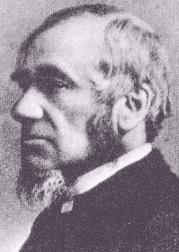
Rev. Canon Henry Twells (1823–1900) was an Anglican clergyman, hymn writer and poet. His best known hymn was "At Even, Ere the Sun Was Set", which was put to music by George Joseph, whose tune Angelus was first printed in 1657. He also wrote the well-known poem, "Time's Paces" that depicts the apparent speeding up of time as we become older. A younger brother, Edward Twells, was the first Bishop of Bloemfontein.

St John's Downshire Hill, Hampstead, is a proprietary chapel of the Church of England, located in Downshire Hill, Hampstead, London, in the Parish of St Stephen with All Hallows. Referred to as St John's Church, the building is formally a chapel. The church should not be confused with St John-at-Hampstead, which is located in Church Row, Hampstead, being the parish church of what is now the neighbouring parish.

Sir William Shelford (1834–1905) was an English civil engineer.
Henry Bellenden Bulteel was an English priest with radical opinions. He studied at the University of Oxford and became an Anglican curate in Oxford. He adopted High Calvinist opinions, and in 1831 gave a polemic sermon before the university in which he questioned received opinions on free will and salvation, and criticised the university and the Church of England for ignoring the principles of their faith and appointing unsuitable clergy in response to political influence. He then went on an outdoor preaching tour, and as a result was ejected from the Church of England. He formed his own nonconformist church and flirted with Irving's Catholic Apostolic Church before setting up a Strict Baptist chapel.
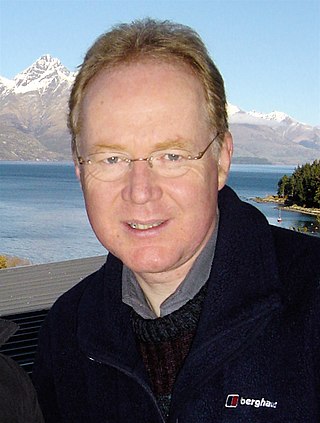
Alastair Murray Cutting is a British Anglican bishop. Since July 2024, he has been Bishop of Woolwich, an area bishop in the Church of England's Diocese of Southwark. From 2013 to 2024, he has served as the Archdeacon of Lewisham & Greenwich. He was consecrated as Bishop of Woolwich on July 3 2024 in Southwark Cathedral.




















